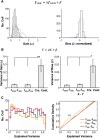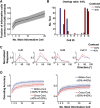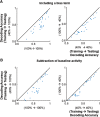Internal Gain Modulations, But Not Changes in Stimulus Contrast, Preserve the Neural Code
- PMID: 30647148
- PMCID: PMC6391566
- DOI: 10.1523/JNEUROSCI.2012-18.2019
Internal Gain Modulations, But Not Changes in Stimulus Contrast, Preserve the Neural Code
Abstract
Neurons in primary visual cortex are strongly modulated both by stimulus contrast and by fluctuations of internal inputs. An important question is whether the population code is preserved under these conditions. Changes in stimulus contrast are thought to leave the population code invariant, whereas the effect of internal gain modulations remains unknown. To address these questions we studied how the direction-of-motion of oriented gratings is encoded in layer 2/3 primary visual cortex of mouse (with C57BL/6 background, of either sex). We found that, because contrast gain responses across cells are heterogeneous, a change in contrast alters the information distribution profile across cells leading to a violation of contrast invariance. Remarkably, internal input fluctuations that cause commensurate firing rate modulations at the single-cell level result in more homogeneous gain responses, respecting population code invariance. These observations argue that the brain strives to maintain the stability of the neural code in the face of fluctuating internal inputs.SIGNIFICANCE STATEMENT Neuronal responses are modulated both by stimulus contrast and by the spontaneous fluctuation of internal inputs. It is not well understood how these different types of input impact the population code. Specifically, it is important to understand whether the neural code stays invariant in the face of significant internal input modulations. Here, we show that changes in stimulus contrast lead to different optimal population codes, whereas spontaneous internal input fluctuations leave the population code invariant. This is because spontaneous internal input fluctuations modulate the gain of neuronal responses more homogeneously across cells compared to changes in stimulus contrast.
Keywords: brain states; mouse visual cortex; population codes; two-photon calcium imaging; visual contrast.
Copyright © 2019 the authors 0270-6474/19/391671-17$15.00/0.
Figures














Similar articles
-
Visual Stimulus Detection Correlates with the Consistency of Temporal Sequences within Stereotyped Events of V1 Neuronal Population Activity.J Neurosci. 2016 Aug 17;36(33):8624-40. doi: 10.1523/JNEUROSCI.0853-16.2016. J Neurosci. 2016. PMID: 27535910 Free PMC article.
-
Audiovisual Modulation in Mouse Primary Visual Cortex Depends on Cross-Modal Stimulus Configuration and Congruency.J Neurosci. 2017 Sep 6;37(36):8783-8796. doi: 10.1523/JNEUROSCI.0468-17.2017. Epub 2017 Aug 8. J Neurosci. 2017. PMID: 28821672 Free PMC article.
-
Enhanced Spatial Resolution During Locomotion and Heightened Attention in Mouse Primary Visual Cortex.J Neurosci. 2016 Jun 15;36(24):6382-92. doi: 10.1523/JNEUROSCI.0430-16.2016. J Neurosci. 2016. PMID: 27307228 Free PMC article.
-
Contrast adaptation and infomax in visual cortical neurons.Rev Neurosci. 1999;10(3-4):181-200. doi: 10.1515/revneuro.1999.10.3-4.181. Rev Neurosci. 1999. PMID: 10526886 Review.
-
Bottom-up and top-down dynamics in visual cortex.Prog Brain Res. 2005;149:65-81. doi: 10.1016/S0079-6123(05)49006-8. Prog Brain Res. 2005. PMID: 16226577 Review.
Cited by
-
Increased Reliability of Visually-Evoked Activity in Area V1 of the MECP2-Duplication Mouse Model of Autism.J Neurosci. 2022 Aug 17;42(33):6469-6482. doi: 10.1523/JNEUROSCI.0654-22.2022. Epub 2022 Jul 13. J Neurosci. 2022. PMID: 35831173 Free PMC article.
-
Mechanisms underlying gain modulation in the cortex.Nat Rev Neurosci. 2020 Feb;21(2):80-92. doi: 10.1038/s41583-019-0253-y. Epub 2020 Jan 7. Nat Rev Neurosci. 2020. PMID: 31911627 Free PMC article. Review.
-
The contribution of low contrast-preferring neurons to information representation in the primary visual cortex after learning.Sci Adv. 2021 Nov 26;7(48):eabj9976. doi: 10.1126/sciadv.abj9976. Epub 2021 Nov 26. Sci Adv. 2021. PMID: 34826242 Free PMC article.
-
Gain control of sensory input across polysynaptic circuitries in mouse visual cortex by a single G protein-coupled receptor type (5-HT2A).Nat Commun. 2024 Sep 14;15(1):8078. doi: 10.1038/s41467-024-51861-1. Nat Commun. 2024. PMID: 39277631 Free PMC article.
-
In vivo extracellular recordings of thalamic and cortical visual responses reveal V1 connectivity rules.Proc Natl Acad Sci U S A. 2022 Oct 11;119(41):e2207032119. doi: 10.1073/pnas.2207032119. Epub 2022 Oct 3. Proc Natl Acad Sci U S A. 2022. PMID: 36191204 Free PMC article.
References
-
- Bishop CM. (2006) Pattern recognition and machine learning. New York: Springer.
-
- Boyd SP, Vandenberghe L (2004) Convex optimization. Cambridge, UK; New York: Cambridge UP.
Publication types
MeSH terms
Grants and funding
LinkOut - more resources
Full Text Sources
